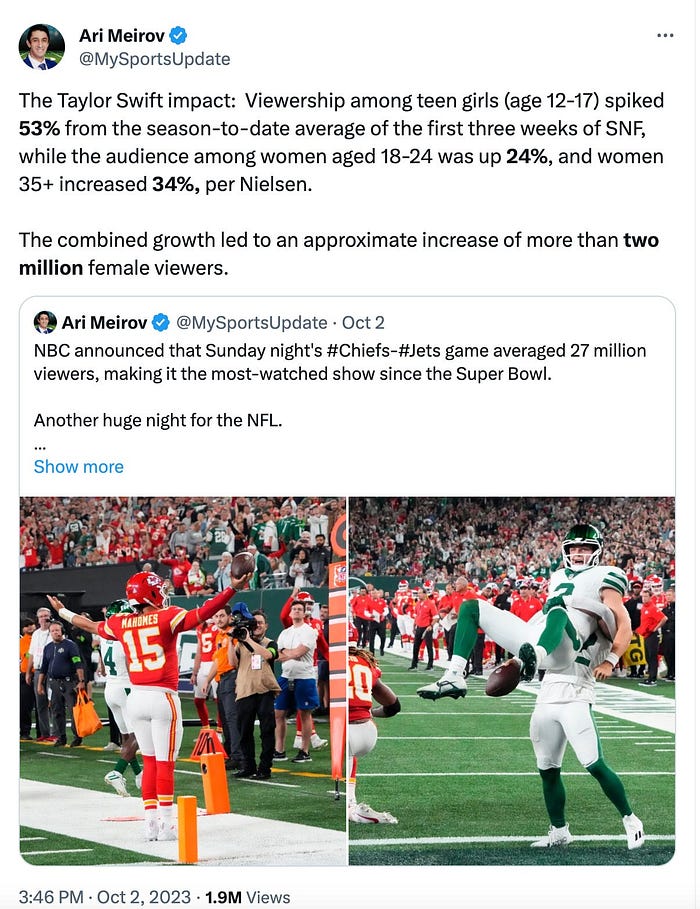Taylor Swift Effect or End of Branding? [Part 2]
Reducing branding to performance marketing.
This blog is the second part of a three-part series delving into the “Taylor Swift effect.” To reiterate, my intention in discussing this effect is to highlight a pervasive issue in today’s marketplace. In Part 1, we explored the prevalent tendency to simplify discussions of her influence through a “main effect” lens. While acknowledging Swift’s financial success and impact, our critique centers on the narrow emphasis placed on sales as the sole measure of her influence, whether economically or culturally. We argue that examining effects, including cultural impact, should go beyond basic cause-and-effect relationships. Taylor Swift serves as a prominent example of this fixation on main-effect leading to sales, illustrating the larger problem.

This issue poses significant challenges for branding strategies and approaches in the marketplace. The prevailing discourse around marketing and the execution of these quasi-branding strategies are all driven by the “main effect” mantra, focused on increasing sales and identifying key branding tactics for this purpose. The widespread adoption of this axiom among various stakeholders in marketing, advertising, and branding is concerning and detrimental. It’s eroding the foundation of brand building and management, making it increasingly difficult to create robust, resilient, and sustainable brands.
In Part 2, we will delve into why this is concerning for brands and detrimental for brand building.
1. Leveraging fame will not help build brands.
Numerous blogs have drawn comparisons between Taylor Swift’s brand and various other prominent brands. As mentioned in the first part of this blog series, Taylor Swift’s brand has been juxtaposed with other franchises (e.g., the NFL), musicians (e.g., Elton John), and cultural products (e.g., Avatar, Harry Potter).
Her romantic involvement with Kansas City Chiefs player Travis Kelce has led some to assert that her brand surpasses the NFL in value. For instance, a Medium blog titled “Taylor Swift Brand Bigger than NFL Digitally” contends that her personal value could potentially allow her to purchase multiple teams from various cities due to her having ten times the number of Instagram followers compared to the NFL. (The brand valuation expertise of these self-proclaimed experts is a source of bemusement #rollingeyes). If you’re interested in understanding how the PR machine operates, there are several blogs that repetitively discuss the comparison between Taylor Swift’s brand and that of the NFL.
- Taylor Swift Bigger than the NFL? The Numbers Don’t Lie.
- The NFL’s Taylor Swift Era: Who Wins the Most?
- Higher, Stronger, Swifter? Taylor Swift goes to a football game and shows she’s bigger than the NFL
- Taylor Swift is Bigger Than the NFL
- Economic Showdown: Taylor Swift vs The NFL Draft
- Taylor Swift Brand bigger than NFL digitally
As previously mentioned, my interest doesn’t lie in dissecting the branding tactics and strategies employed by Taylor Swift or engaging in discussions about whether Taylor Swift is a more valuable brand than NFL or others. Instead, my focus is on shedding light on how Taylor Swift-inspired quasi-brand strategies are impacting brands, branding approaches, and other stakeholders in the marketplace. Since we initiated the discussion with the NFL, I will continue to deepen the argument using the NFL as an illustrative example.
There’s no denying that Taylor Swift has a substantial impact on NFL viewership for the games she attends in person. However, the industry’s fixation remains on a singular “main effect” perspective: Taylor Swift attending an NFL game leads to increased rankings and viewership. A significant portion of these new audiences aligns with a demographic segment the NFL has long sought after — young, female, and emotionally engaged fans. I’m not here to cast blame on the NFL for being captivated by the rising viewership numbers when Taylor Swift is in attendance & bringing her Swifties along. My point is that capitalizing on this phenomenon does not equate to a comprehensive branding strategy.

The NFL is in dire need of effective branding strategies that can establish and maintain a robust, enduring, and defensible brand. The NFL has grappled with numerous branding issues, particularly following Colin Kaepernick’s kneeling protest. Similar challenges related to diversity, equity, and inclusion have persistently plagued the NFL. While I’m not a fervent football enthusiast (coming from a place where it’s known as soccer 😎), I am well-informed about the significant disparities in hiring and retention along racial lines that suggest discrimination within the league. (I plan to delve into this DEI issue in another blog focused on the league’s brand.) My point here is that the NFL has grappled with branding difficulties both before and on multiple occasions, and it requires a sound strategy to cultivate a durable and resonant brand. Part of this branding strategy should seek to remain relevant in this attention-driven marketplace. The NFL urgently needs to transform its brand to foster greater engagement across diverse audiences, particularly among the younger and female demographics. Although enticing Swifties may seem like a potential solution to this challenge, regrettably, this current “borrowing Swifties attention” approach falls short.
The NFL and its broadcast partners have been unwavering in their promotion of her appearances, especially during the “Welcome to New York” Jets matchup, despite the game being played in New Jersey. They are capitalizing on Taylor Swift’s fame and the considerable attention, including those coveted ratings, she brings to the games from a female audience demographic they’ve long aspired to engage. The league is enthusiastic about the impact her mere association with the NFL has had on demographics that typically aren’t its strongest suit. But, this will not give the league a strong and defensible brand position. I’ll provide more insights into the reasons behind this in the following section.
Read the rest of the blog on my Cultural Faultlines newsletter on Substack.
